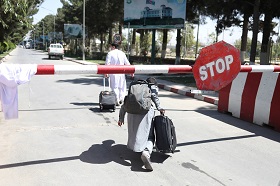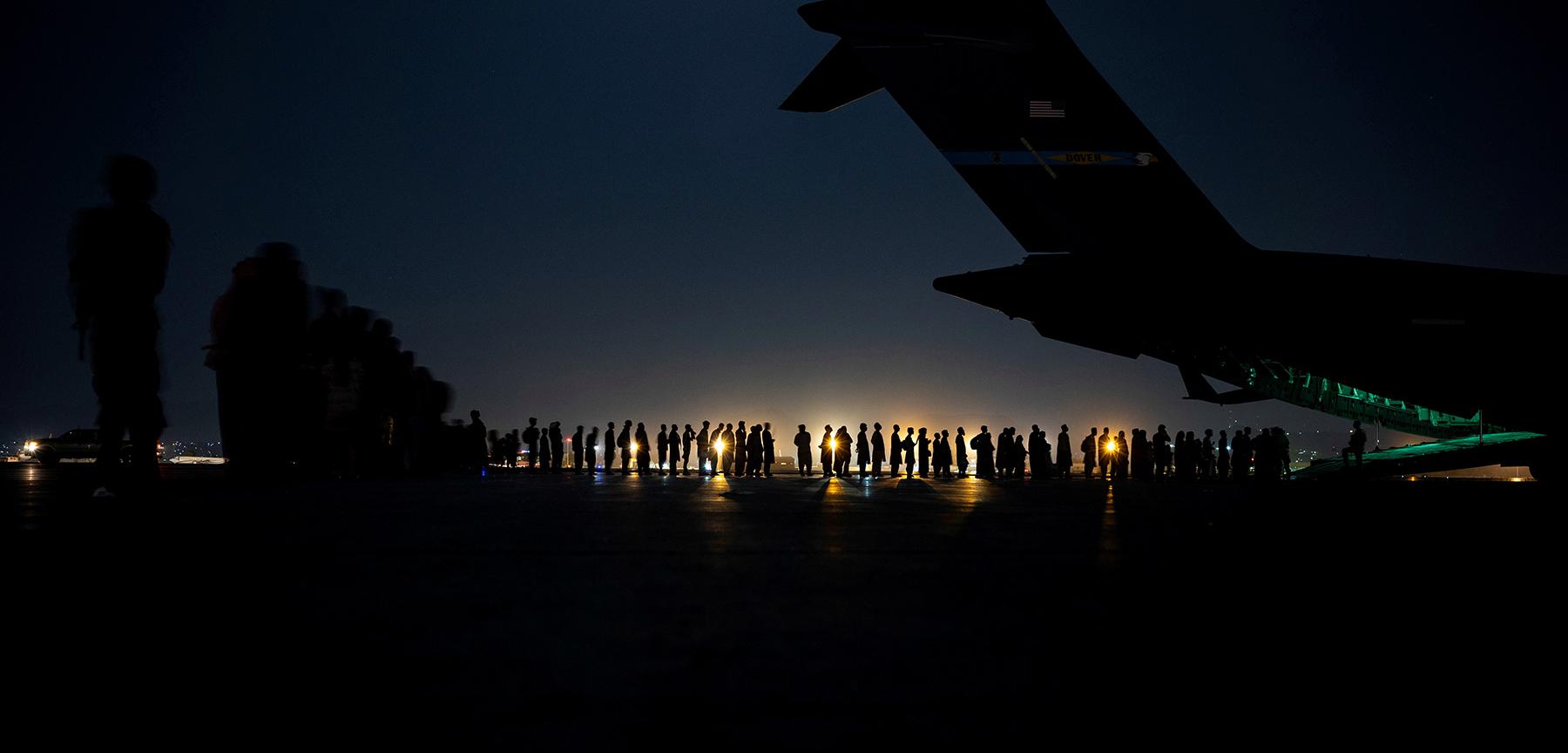The hasty withdrawal of the U.S. forces from Afghanistan attests to both the indifference of the U.S. administration as regards the future of Afghanistan as a state and the neglect for its obligations to its allies. Besides, Washington has clearly violated the current UN Security Council sanctions regime against the Taliban, which was established in accordance with Resolution 1988 (2011).
Washington faced serious backlash for violating the UN sanctions regime upon abandoning weaponry and ammunition during an abrupt evacuation of troops from the country—such as when U.S. troops left Bagram, the largest airbase in Afghanistan, without warning the local Afghan army in early July, 2021. General Mir Asadullah Kohistani, the new commander of Bagram Air Base, stated that Afghan soldiers only later learned of the Americans having departed, once they had all “disappeared into the night.” Since U.S. troops had turned off electricity at the airbase, looters soon found their way in, with barracks and storage tents ransacked. Among the “trophies” left by the Americans were hundreds of armored vehicles and ammunition, all of which ended up in the hands of the Taliban.
This is not the first time that Washington has violated a UN Security Council Resolution. For example, a statement by Sergei Ryabkov, Deputy Foreign Minister of the Russian Federation, suggests that the United States released four Taliban members from Guantanamo in 2014, all of whom were on the Security Council sanctions list, to send them to the Middle East.
It is important to recognize that the “Taliban issue” could become somewhat of a scapegoat for Washington, especially in the eyes of its allies, to impose even more anti-Russia sanctions. In addition to the Executive Order on Blocking Property with Respect to Specified Harmful Foreign Activities of the Government of the Russian Federation signed on April 15, 2021, the White House published a Fact Sheet outlining key accusations against Russia, which include reports on rewards for the murder of U.S. soldiers in Afghanistan.
One should bear in mind that the United States and Russia are adopting more polarized stances regarding the situation in Afghanistan, which became evident during the UN Security Council meeting on August 30, 2021, when Moscow and Beijing refrained from supporting the West-drafted resolution on Afghanistan. Thus, Washington will look for any excuse to discredit Russia. An effective instrument in counteracting such sanctions, hoaxes and other foul play common for the United States should be that of keeping a meticulous record of Washington’s violations of the UN Security Council sanctions regime against the Taliban to present the findings to the international community.
The hasty withdrawal of the U.S. forces from Afghanistan attests to both the indifference of the U.S. administration as regards the future of Afghanistan as a state and the neglect for its obligations to its allies. Besides, Washington has clearly violated the current UN Security Council sanctions regime against the Taliban, which was established in accordance with Resolution 1988 (2011).
Paragraph 1, subparagraph (c), of the Resolution calls on all countries to “prevent the direct or indirect supply, sale, or transfer of arms and related material of all types including weapons and ammunition, military vehicles and equipment, paramilitary equipment, and spare parts” to the Taliban and other individual groups, undertakings and entities associated with them [1].
Washington faced serious backlash for violating the UN sanctions regime upon abandoning weaponry and ammunition during an abrupt evacuation of troops from the country—such as when U.S. troops left Bagram, the largest airbase in Afghanistan, without warning the local Afghan army in early July, 2021. General Mir Asadullah Kohistani, the new commander of Bagram Air Base, stated that Afghan soldiers only later learned of the Americans having departed, once they had all “disappeared into the night.” This is important as this proves that the Americans did not transfer weaponry and ammunition to the Afghan army through official channels. Since U.S. troops had turned off electricity at the airbase, looters soon found their way in, with barracks and storage tents ransacked. Among the “trophies” left by the Americans were hundreds of armored vehicles and ammunition, all of which ended up in the hands of the Taliban, either that very night or after Bagram being taken over (see image 1).
Image 1: Armored vehicles (left) and ammunition (right) deserted by the Americans at Bagram Airbase.

Source: RIA Novosti (left) and Haroon Sabawoon – Anadolu Agency (right)
According to The Military Balance, a military journal published annually, Afghan government forces had 640 MSFV armored security vehicles, 200 MaxxPro armored fighting vehicles and several thousand Hummers at their disposal. The Afghan Air Force had 22 EMB-314 Super Tucano (А-29) light attack aircraft (see image 2), four C-130H Hercules transport aircraft, 24 Cessna 208B and 18 turboprop PC-12s. The Army Air Corps boasted 41 MD-530F light turbine helicopters and as many as 30 multi-mission UH-60A Black Hawk helicopters (see image 2).
Image 2: A light attack EMB-314 Super Tucano (А-29) aircraft captured by the Taliban at Mazar-i-Sharif International Airport (left) and a light MD-530 F multi-role helicopter (center); a multi-mission UH-60A Black Hawk helicopter in the sky above Qandahar with what seems to be a person hanged by the Taliban (right).

Source: Twitter
On August 17, 2021, Jake Sullivan, U.S. National Security Advisor, confirmed that a significant amount of U.S. weapons had fallen into the hands of the Taliban. “And obviously, we don’t have a sense that they are going to readily hand it over to us at the airport,” he noted, thus confirming that the United States allowed the indirect transfer of weapons to what the UN Security Council has designated a terrorist organization.
This is not the first time that Washington has violated a UN Security Council Resolution. For example, a statement by Sergei Ryabkov, Deputy Foreign Minister of the Russian Federation, suggests that the United States released four Taliban members from Guantanamo in 2014, all of whom were on the Security Council sanctions list, to send them to the Middle East.
This was quite in line with the U.S. policy incepted back in 2010 and aimed at engaging in direct dialogue with the Taliban. This led to the UN Security Council Committee—established pursuant to Resolution 1267 on sanctions against the Taliban and Al-Qaeda—breaking up into two independent sanction mechanisms [2]. The UN Security Council Committee established pursuant to Resolution 1988 devised procedures that allow for a more liberal approach to the Taliban list (compared to those involved with Al-Qaeda), excluding those mentioned in consolidated lists of persons, groups and entities subject to restrictions.
Such facts should, in fact, be subject to the scrutiny of the UN Security Council Committee established pursuant to Resolution 1988 (including its Analytical Support and Sanctions Monitoring Team), in whose proceedings the Russian Federation takes part and whose mandate implies monitoring compliance with Taliban-related sanctions as well as presenting periodic reports on sanctions measures to the Security Council.
Prospects of the U.S. imposing sanctions against Russia in connection with the Taliban
It is important to recognize that the “Taliban issue” could become somewhat of a scapegoat for Washington, especially in the eyes of its allies, to impose even more anti-Russia sanctions. In addition to the Executive Order on Blocking Property with Respect to Specified Harmful Foreign Activities of the Government of the Russian Federation signed on April 15, 2021, the White House published a Fact Sheet outlining key accusations against Russia, which include reports on rewards for the murder of U.S. soldiers in Afghanistan. According to the document, the Biden administration is taking measures following the intelligence reports of Russia having encouraged Taliban attacks on the U.S. and alliance contingent in Afghanistan. Since such allegations directly affect the safety and well-being of U.S. troops, a solution can be found through diplomatic, military and intelligence channels.
Biden’s executive decree foresees the introduction of blocking sanctions for attempts to challenge the credibility of elections in the United States and allied countries, malicious hacker activities, spreading corruption internationally, crackdowns on dissidents and journalists, undermining security and stability in countries and regions important for U.S. national security interests, and the violation of international law, including the territorial integrity of states.
The reason for the Biden administration’s concern is likely a story published in The New York Times in June 2020 claiming that Russian military intelligence had offered Taliban-affiliated militia a reward for the murder of U.S. soldiers in Afghanistan. Sources of the newspaper claimed to have uncovered such information during interrogations of Afghan militia.
As a result, senator Robert Menendez suggested in September 2020 that the U.S. Congress move forward with yet another anti-Russia sanctions package, the Russia Bounty Response Act of 2020. The Act implied freezing assets, visa restrictions for President Vladimir Putin, Minister of Defense Sergei Shoigu and other high-ranking officials, as well as restrictions on defense enterprises. The initiative was supported by Dem. Nancy Pelosi, Speaker of the U.S. House of Representatives. In an interview with MSNBC, she emphasized the need to immediately impose sanctions against Russia for “colluding” with the Taliban.
In his turn, however, former President Donald Trump called The New York Times story “a fake,” stating that the article had been ordered for political reasons. Trump went on to state that the U.S. intelligence had acknowledged the information used in the publication was misleading. Pentagon spokesman Jonathan Hoffman said there was no evidence of a “conspiracy” between Russia and Taliban officials. The Taliban also denied information from The New York Times about existing ties with Russia.
One should bear in mind that the United States and Russia are adopting more polarized stances regarding the situation in Afghanistan, which became evident during the UN Security Council meeting on August 30, 2021, when Moscow and Beijing refrained from supporting the West-drafted resolution on Afghanistan. Thus, Washington will look for any excuse to discredit Russia. An effective instrument in counteracting such sanctions, hoaxes and other foul play common for the United States should be that of keeping a meticulous record of Washington’s violations of the UN Security Council sanctions regime against the Taliban to present the findings to the international community.
1. The Taliban is a terrorist organization that is banned in Russia under Decision No. 03-116 of the Supreme Court of the Russian Federation dated February 14, 2003, which entered into force on March 4, 2003.
2. Al-Qaeda is a terrorist organization that is banned in Russia under Decision No. 03-116 of the Supreme Court of the Russian Federation dated February 14, 2003, which entered into force on March 4, 2003.








